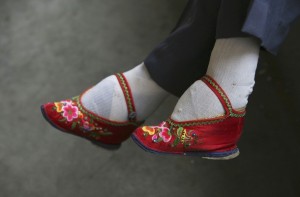Fashion and beauty trends go in and out of style constantly. On one day, the trend to dye your hair grey may be popular, and a month later, a more natural look will be back in vogue. This ever-changing aspect of fashion is not exclusive to the society of today. The fickle nature of beauty trends can be seen throughout history in societies and cultures around the world.
One such trend is foot binding in Chinese culture, which began to become a widespread custom during the late T’ang and early Sung periods – around 750-110 AD (Greenhalgh, 8). To the West, foot binding is seen as a horrible practice that leaves girls disabled for the rest of their lives, but within the Chinese culture, it is a status marker. The word itself in the Chinese language refers to the beautiful images of a new moon or lotus petal, rather than a deformed foot (Chang, 20). In order to actually reshape the foot, so as to achieve such a delicate and small appendage, women would stretch and bend the ligaments and tendons, in turn, shifting the placement of the bones of the foot – unlike the preconception that the women break their toes to attain the desired shape (Ko, 60). This then, results in the girl walking on the knuckles of her toes and her heel (Chang, 20).
This practice first came about in the elite upper classes of Chinese society, and remained in that status until the seventeenth and eighteenth centuries. Women with bound feet could not preform work like other women; they could not work in the fields, or stand for long hours, in turn, showing their higher class and wealth. This, however, all changed when many peasant girls began to bind their feet in the eighteenth century (Ko, 12). As more and more lower class woman began to emulate their upper class contemporaries, foot-binding lost its former appeal, turning from being an exclusive act of the upper-class to an almost vulgar and overused part of society (Ko, 12). As time went on, people began to see the downsides to foot-binding and slowly stopped performing the action.
Today, foot binding is only seen in the women who were subjected to the practice as a child, and no longer exists as a living tradition. In the past, women with bound feet were thought of as delicate and beautiful; therefore, foot binding was used as an action toward perfecting a woman for her future husband. By thinking of the tradition in this way, it is easy to see why the practice is not continued today. Feminists could argue that society pressures these women to bind their feet, and live a life of pain, just so that they can fulfill the culturally constructed ideals of what a woman should look and act like, so as to garner a perfect spouse. The ancient Chinese viewpoint sees to go against our modern thinking – that a woman should be equal to any man and act as she wants – but are we all that different? We still allow ourselves to be ruled by other’s perceptions of our styles, bodies, personalities, etc. so much so, that we are no different than the women who bound their feet decades ago. In order for society’s opinion to change, we must, as individuals, alter our perspectives on how we view body differences and alterations.
Greenhalgh, Susan. “Bound Feet, Hobbled Lives: Women in Old China.” Frontiers: a Journal of Women Studies. 2.1 (1977): 7-21. Print.
Chang, Pang-Mei N. Bound Feet & Western Dress. New York: Doubleday, 1996. Print.
Ko, Dorothy. Every Step a Lotus: Shoes for Bound Feet. Berkeley: University of California Press, 2001. Print.


